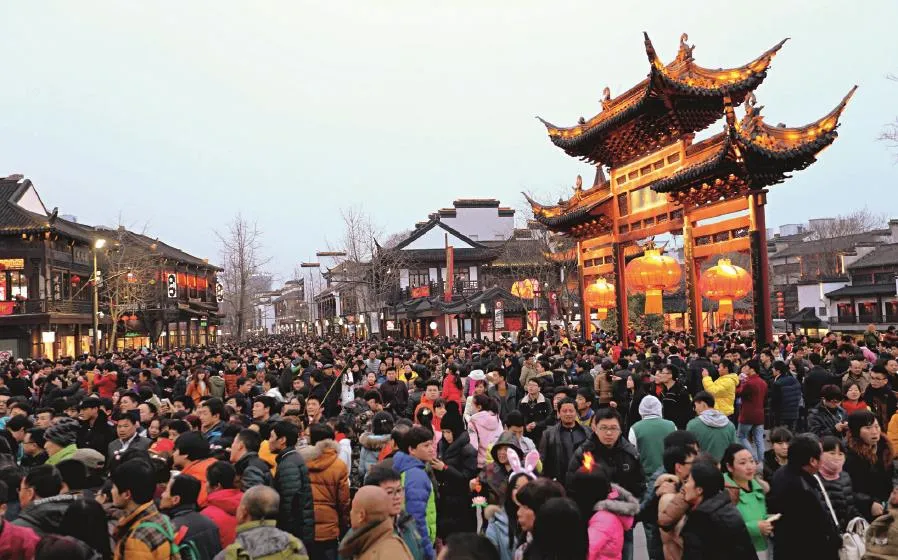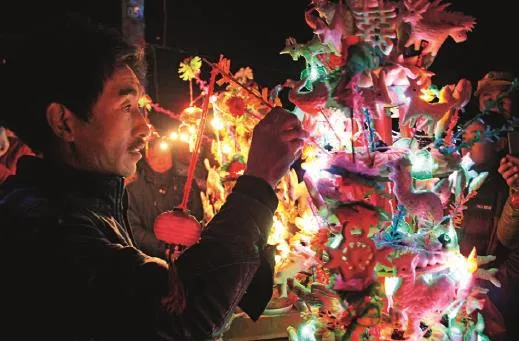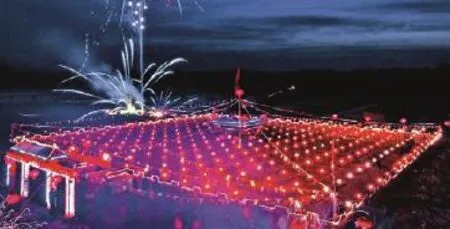Lantern Festival Conventions
2016-09-12BystaffreporterZHANGLI
By staff reporter ZHANG LI
Lantern Festival Conventions
By staff reporter ZHANG LI

The Confucius Temple in Nanjing recieves numerous visitors during the Lantern Festival.
THE Chinese Lantern Festival is celebrated on the first full moon of the new lunar year, which always falls on the 15th day of the first lunar month. Family members gather on this happy evening to adorn their homes with lanterns and streamers and make merry.
The festival is the last of the two weeks or so of Spring Festival celebrations that begin on Lunar New Year’s eve. Customary activities on that evening include lantern counting and eating glutinous rice balls. The event is now an item of national intangible cultural heritage.
Origins
Until the end of the 9th century this occasion was known as the Shangyuan Festival. It is believed to have originated in the Western Han Dynasty (206 BC-AD 8). It was on the 15th day of first lunar month that Emperor Wendi quelled a palace coup. He celebrated the anniversary each year by leaving the palace dressed in everyday garb to celebrate the anniversary of that victory with his subjects. Shangyuan thus became a major festival on the taichu calendar, China’s first complete calendar created in 104 BC.
During the Han Dynasty the lantern display was confined to the night of the 15th day of the first lunar month. In the Tang Dynasty (618-907), however, it lasted for the three days from the 14th to the 16th day of that month. At that time, Chang’an, the capital, was a lively metropolis with a population of more than one million. On the royal initiative, the lantern display became a large-scale festivel activity featuring thousands of lanterns of various shapes and sizes.
In the Song Dynasty (960-1279), the festival took on more folk-like features that included lantern counting and eating yuanxiao, or sticky rice balls. It is hence also known as the Yuanxiao Festival. Yuanxiao are small, spherical glutinous rice flour dumplings with fillings made from rose petals, sesame, red bean paste, jujube paste, walnuts, dried fruit, and sugar that can be boiled, fried or steamed. Enjoyment of these sweet, delectable dumplings extends to an appreciation of family harmony, happiness and unity.

Colorful lanterns illuminate the festival.
Lunar New Year celebrations in the Ming Dynasty (1368-1644), featured a lantern festival from the eighth to the 17th day of the first lunar month. It was an occasion celebrated with dramas and other performances.
The festival is also a romantic holiday. When China was still a conservative feudal society, unmarried maids were strictly confined to their households and chores, and permitted to go out only on holidays. The lantern display was consequently a good opportunity for single men and women to meet marriage partners.
Social changes over time have brought with them modifications to the customs and mores of the Lantern Festival. It nevertheless remains one of the most significant traditional Chinese festivals.
Local Customs
In addition to eating yuanxiao, enjoying the spectacle of decorative lanterns and trying to count them, different localities also maintain their own Lantern Festival customs and traditions.
Lianqiao Rice
This three-day annual activity that takes place in Dayangshu Dixia Village of Beijing’s Huairou District began more than 180 years ago.
It originates in the legend of how the Jin and Huo clans – the family name of most of the village’s 150 householders – fled Shandong Province and came to settle in the area, but did not bring with them any seeds to sow. A group of men from the newcomers journeyed far to borrow a bag of millet, but accidentally dropped it down a narrow stone crevice. Just as they were about to despair, a flock of fairy sparrows suddenly arrived and picked the seeds out for them. The men made a vow of gratitude to share their harvests with these birds every spring.
It has been the custom in the village ever since for young girls to go doorto-door on the day after the Lantern Festival to collect Spring Festival leftovers, usually rice and vegetables. In the local dialect, lian means collecting, and qiao refers to sparrows, titmouses and other small birds. When the girls come home with the food they have collected, their mothers help cook it over wood fires, and share these concoctions with their fellow townsfolk. But before sitting down to dinner the villagers first feed the sparrows and other small birds in gratitude for bringing the seeds to their ancestors, and also in hopes of a fruitful harvest in the coming year.
It is also customary to include needle, thread, and thimbles into the woks. Girls that find them in their bowls are deemed to have seamstresses’ “nimble fingers.” After the meal, villagers take a ritual walk on the frozen surface of ponds or streams, because walking on ice is believed to ward off illnesses.

Lianqiao Rice dates back more than 180 years.

The Winding Yellow River Lantern Maze is a festival combining the ancient tactical formation and folk lantern festival.
Winding Yellow River Lantern Maze
A number of characteristic folk activities take place during the Lantern Festival in regions along the Yellow River like northern Shaanxi, Inner Mongolia, and Shanxi. Of them, the Winding Yellow River Lantern Maze, which combines ancient tactical formations with the folk lantern gala, is the most fun.
The lantern maze consists of four rotating matrixes representing the four seasons and the accompanying 24 solar terms. It signifies a smooth, uneventful coming year. Those who walk through the maze hope to avoid ill fortune and enjoy a long life.
There is just one way out of the 1,400-square-meter-large maze, so anyone taking a wrong turn gets lost. During the course of the evening, various performance troupes gather in the village, and local residents join and interact with them as they walk through the maze.
Immigrants from Shanxi brought this convention to Beijing’s Miyun County in 1371 as a way of remembering their hometown. In 2008, the county applied to have this convention classified as nation-level intangible cultural heritage.

Liulin Altar Fair.
Altar Fair in Liulin
This grand folk cultural activity, held in Liulin County, Shanxi Province, starts on the 13th and ends on the 26th day of the first month of the lunar calendar. As the Lantern Festival is its climax, locals accordingly decorate the streets with lanterns and streamers, but they also build altars at which to pray for favorable weather in the coming year.
In the Ming Dynasty, local craftsmen began scaling down temples to create a more folk-like ethos. They fashioned wooden altars that could be easily dismantled on which to place holy figurines. Such simplified altars are usually four meters tall, and enshrine mythological figures such as the God of Fortune and the Boddhisatva Guanyin, (Goddess of Mercy). There are more than 200 wooden altars in Liulin where local residents offer sacrifices to gods or to their ancestors. The oldest was made in 1900.
The building of altars starts two days prior to the Lantern Festival. Some take only a couple of hours while more ornate ones need two or three days. People make various offerings of food, especially cooked wheaten figures in the shapes of pigs, goats, and fishes, to place on the altars. In the evenings local residents gather around an open fire to enjoy performances by folk artisans.
There are many explanations for the function of this festival, the major one that it is to pray for offspring. Young couples take home with them some of the dough models, and if the wife becomes pregnant they bring with them more offerings the next year to redeem a vow to the god. Around the altar hang many red lanterns on which are brushed the characters meaning “whatever requested is granted.”
The altar fair celebrates folk art and skills and is also an activity to enhance unity and mutual help. Each altar is a symbol of a community organization, including its funding, building and daily maintenance. Democratic autonomy is one of the important foundations of rural social stability.
Lantern Counting in Dongshi
Lantern counting has a history of about 300 years in Dongshi, a township on the Jinjiang river estuary of the Taiwan Strait in Fujian Province. At the Lantern Festival, it was customary for locals to hang lanterns in the Jiaying Temple as a worship ritual, especially newly-wed couples.
On the other side of the strait, there is another town that shares both the name Dongshi and this convention. During the Ming and Qing (1644-1911) dynasties, many people in Dongshi of Jinjiang sailed to Taiwan to make a living, and later gave the new settlement the same name as their hometown. Emigrants built a branch temple in the new Dongshi in Chiayi County and carried on the lantern custom.
On the 13th day of the first lunar calendar month, men who have been married for a year first hang up lanterns and then count all those on display around the largest one at the center, to try to guess how many men married the previous year. At night, recently-wed couples gather here to admire the festive lanterns and enjoy the accompanying activities. They later take lanterns home with them to pray for a child.
Every Lantern Festival, the residents of both Dongshis make guesses at the number of lanterns that illuminate the festival in hopes of fertility and prosperity. This tradition is witness to the kindred relationship between peoples on both sides of the Strait. It was listed as a national intangible cultural heritage in 2008.

The activity of Count Lanterns in Dongshi.
Baidengshan Ritual in Yuxian County
The Baidengshan ritual, in which lanterns are arranged in a worshipful array, has a history of more than 450 years. Originally a folk ceremony, it is one of many festival entertainments.
It starts on the 12th day of the first lunar calendar month, and comprises four parts. The first is lighting the lanterns, the second making obeisance to them, third are festival activities, and fourth drama performances. First, ritual offerings and hundreds of lanterns are variously arranged on a huge wooden support. That evening the lanterns are lit, one by one, to illuminate these displays. A boy is chosen to lead local people and visitors in prayers for peace and prosperity in the coming year. Parents heave up their children to help them touch a high spot on the lamp pole in hopes this will make them grow tall and have a prosperous future. Young couples also take six lanterns home from the display to pray for a baby.
The festival activities then begin – happy events for both performers and audience. The highlight of the evening is a drama performance by local amateur actors in which they tell old stories and legends.

The ritual procession through Baidengshan in Yuxian County.
